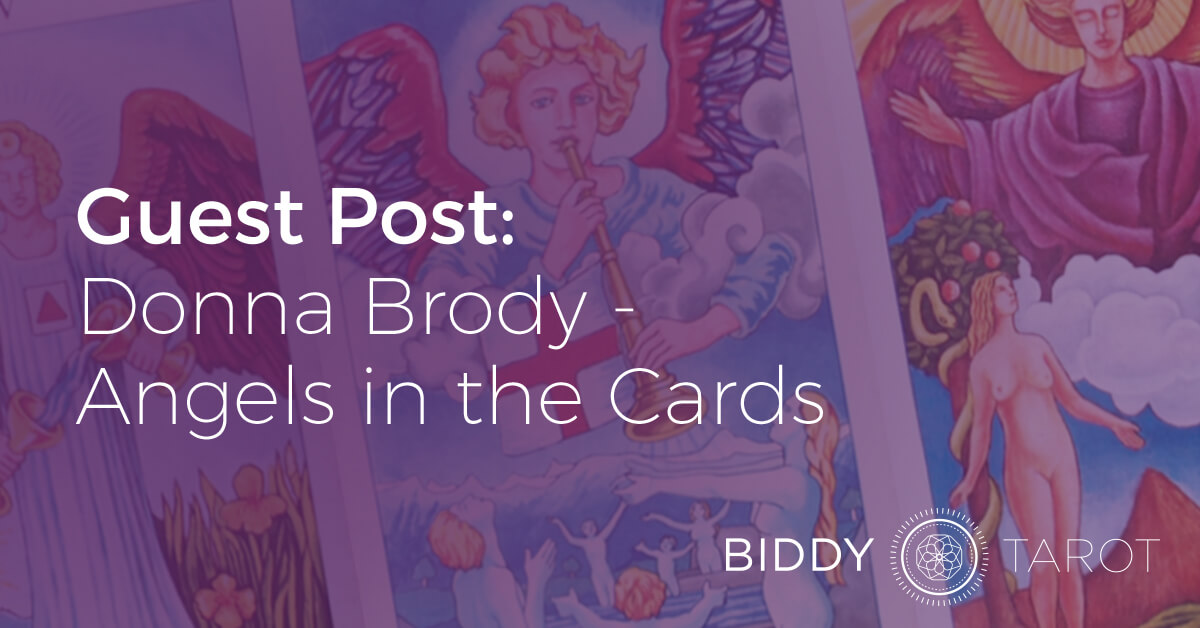 This week, I welcome back Donna Hazel, who previously shared with us the Tarot Birth Cards of the ‘rich and famous'. This time, Donna explores the angels in the Tarot cards, delving deep into their significance within the Tarot. I bet you will learn something you didn't already know (I know I did!). Over to you Donna… There are six Tarot cards explicitly depicting angels. Specifically, they are in the Major Arcana and are Archangels, from the Greek archangelos or “Chief Messenger”. Although in our Tarot cards the angels have been represented according to typical early Christian art, in full regalia of gown and wings, this lack of subtlety was no doubt entirely deliberate – this is a message not to be missed! Even their wings expand through the borders of the cards with the suggestion of the unlimited, the infinite, of what is beyond the mundane and materially perceptible, or even just aspects of a situation you can’t perceive. Angels or divine messengers feature in most dominant world cultures and religions. In the West they can be traced back as far as Ancient Greece. Plato called them “daemons” (not to be confused with the Judeo-Christian “demons”) in The Symposium and described them as “intermediaries” between men and gods. In The Apology Socrates claims to have a daemonic “divine something”; a voice which would act as a warning (although it never told him what to do). There are many angels and Archangels but only the four mentioned in the Book of Enoch made it into the Tarot cards. These are Raphael, Gabriel, Uriel, and Michael. The most famous, dense and intense work on angels remains the Summa Theologica by Thomas Aquinas (c1225-1274). Here he discusses angelic substances and Grades, Orders and Hierarchies of angels, amongst many other angelic issues. It’s a tough read, but if you are interested in angels you will find this provides the backdrop for much of what we know about angels today.
This week, I welcome back Donna Hazel, who previously shared with us the Tarot Birth Cards of the ‘rich and famous'. This time, Donna explores the angels in the Tarot cards, delving deep into their significance within the Tarot. I bet you will learn something you didn't already know (I know I did!). Over to you Donna… There are six Tarot cards explicitly depicting angels. Specifically, they are in the Major Arcana and are Archangels, from the Greek archangelos or “Chief Messenger”. Although in our Tarot cards the angels have been represented according to typical early Christian art, in full regalia of gown and wings, this lack of subtlety was no doubt entirely deliberate – this is a message not to be missed! Even their wings expand through the borders of the cards with the suggestion of the unlimited, the infinite, of what is beyond the mundane and materially perceptible, or even just aspects of a situation you can’t perceive. Angels or divine messengers feature in most dominant world cultures and religions. In the West they can be traced back as far as Ancient Greece. Plato called them “daemons” (not to be confused with the Judeo-Christian “demons”) in The Symposium and described them as “intermediaries” between men and gods. In The Apology Socrates claims to have a daemonic “divine something”; a voice which would act as a warning (although it never told him what to do). There are many angels and Archangels but only the four mentioned in the Book of Enoch made it into the Tarot cards. These are Raphael, Gabriel, Uriel, and Michael. The most famous, dense and intense work on angels remains the Summa Theologica by Thomas Aquinas (c1225-1274). Here he discusses angelic substances and Grades, Orders and Hierarchies of angels, amongst many other angelic issues. It’s a tough read, but if you are interested in angels you will find this provides the backdrop for much of what we know about angels today.
What are Angels?
Spiritual beings or entities. There are two ongoing debates about the status of angels in the Bible. One concerns whether they are the departed spirits of men or whether they are inhuman divine beings created by God, who never were incarnated as human. The second and related controversy concerns whether we are ourselves essentially angelic. One can find “evidence” either way; however there do seem to be places where Jesus (and Lot) do indeed find themselves discoursing with what appear to be the dead. In Matthew (17:1:3) John, James and Peter behold Jesus conversing with the (dead) Moses and Elijah. It is unclear whether the dead men were angels or ghosts (or both). Whereas with the appearance of the Archangels, it appears that these were never human. Jesus also tells us that we are angels in Heaven (Matthew [22:30]). This was one basis – along with ambiguous remarks such as the Kingdom of Heaven is Within – leading to the view that we are essentially angels ourselves, but “fallen” and unaware of it from our embodied and limited conceptual horizons. The notion of Ascension is accordingly that we are on a lesson to restore or regain the spiritual knowledge we once had. The idea here is that our essence or true nature is divine or spiritual (although the two terms are often conflated: what is spiritual is not necessarily divine). The idea of regaining lost knowledge predates Christianity and can be found in Plato’s theory of anamnesis or recollection. We once had Absolute Knowledge but, when incarnated or re-incarnated, we forgot it. The seat of Absolute Knowledge he called Forms, the perfect archetypes of everything we encounter here below. Plato’s Forms were in part an attempt to account for where we get the idea of perfection from when nothing earthly ever instantiates it. Much later, Descartes makes a similar move when he asks from where we have a notion of the Infinite as we cannot experience or even conceive of it. Answer: God put the idea in us. Plato did not have a notion of a benevolent and omnipotent God but he did consider that the “source” or reason [logos] for existence was the One Beyond Being [epekeina tes ousias], later elaborated upon by Plotinus. Although the appearance of angels as we know them today was a much later artistic addition, as purely spiritual entities, strictly speaking, they have no form. Frequently in the Bible they appear as men. In fact, they were pretty notorious for appearing in disguise, often as people. Raphael is one. Theoretically, then, they can take on any form. So, although the Archangels only appear explicitly in six cards, perhaps there is an implied presence in many of the other cards too.
Angels of the Tarot
Let’s turn to how the traditional aspects and attributions of Archangels might be illustrated and reflected in the meanings of our Tarot cards.
Raphael
[God’s Healing] in the Lovers card. Raphael is not mentioned in the Bible but he does appear in some of the Apocryphal (or “hidden”) books; specifically, the Deuterocanonical book of Tobit. In the Islamic Hadith he is called Israfil. In the book of Tobit he appears disguised as a travelling companion and restores the eyesight of Tobit. He also binds a demon named Azazel and saves Tobit’s daughter-in-law, Sarah, from another demon, Asmodeus (responsible for lust). Accordingly, Raphael is seen as the Healing Angel and the patron saint of the blind, the sick, the healing professions, lovers and travellers. He is also considered to drive away nightmares and often depicted as a young man holding a flask and/or a fish. Page of Cups anyone? The Lovers card in the Tarot clearly exemplifies the love aspect of Raphael’s patronage. However the card is also about his other modalities and can suggest travel, health and healing. It can also signify an important choice to be made or a temptation to be resisted (Asmodeus!) often putting the two together as a trial of love involving an important decision.The FREE 5-Day
Tarot Reading Challenge
Become a More Confident,
Intuitive Tarot Reader
Join Brigit Esselmont
for an EXCLUSIVE Live Event
April 28th - May 2nd
Gabriel
[Man of God] in the Temperance card. Gabriel is our biggest “messenger” angel in the Tarot. He appears a number of times in the Bible as a messenger of God to interpret dreams and visions, most notably those of Daniel in the Book of Ezekiel, the Virgin Mary to foretell the birth of Jesus (Luke [1:11]) and to the Shepherds (Luke 2:9-14). It is also said that it was Gabriel who revealed the Koran to Muhammed. Gabriel is named in the New Testament (Luke 1:9-26). The only other angel to be named is Michael (Jude 1:9). Gabriel’s messages concerned the transformation of the spiritual into matter, or spiritually infused matter, and telling the future. They were about time, and timing, and the blending of the spiritual with the earthly. The Temperance card mirrors these messages and is about a sense of correct proportion and timing with combinations and mixtures. It is about patience, moderation, and harmony. The blending of different elements brings about a new creation. The card asks us to take a view best expressed by Spinoza: to view all things sub specie aeternitatis (in the context of eternity). In the vernacular, don’t sweat the small stuff!Uriel
[Fire of God] in the Devil card. Uriel is a little ambiguous in that he is not to be equated with Lucifer [Light Bearer] or Satan [Adversary]. Uriel appears in the Book of Enoch (20:1-18). He often does good and is an Angel of Presence (allowed to enter the presence of God) but he is also seen as a firey and pitiless angel of the Earth and holds the key to the End of Time. In fact, the Catholic Church removed him from their list of angels suitable for veneration. The Devil card in the Tarot often depicts a Baphomet type Devil so it is with some ambiguity that he is identified as the angel Uriel. It could be his association with the keys to pit and as an angel of repentance. However, of course, angels can appear in disguise… The Devil card shows a tableau of enchainment or enslavement to earthly or material forms of desire. These could be external or self-imposed. It asks us to repent or release the attachments in order to free ourselves from limitations and oppression. The chains around the necks of the couple in the card are loose – they could lift them off if they really wanted. In that sense it is a card of hope. When the Devil shows up in a reading it may indicate a reluctance or refusal to leave an unhealthy situation of dependency. It can also suggest repressed fears. Occasionally it is an invitation to break loose, adopt a devil-may-care attitude and have some fun!Michael
[Who is Like God] in the Judgement card. Over time Michael came to be regarded as the primary protecting and healing angel. In the Bible he was the Defender of God’s realm against Satan in the Book of Revelation. He is also the Angel of the Lord and the Angel of the Dead, carrying deceased souls to Heaven – which probably explains his presence in the Judgement card. He was seen to give each soul, at the hour of death, a chance to redeem itself before passing over. Sometimes he is shown weighing souls in a balancing scale – which also recalls the Justice card or even the Six of Pentacles. In the Egyptian Coptic Church he has a similar role in presenting the prayers of the just to God and in accompanying departed souls to Heaven. He might even be present in the High Priestess card – sometimes she is seen as Hathor, and Michael is celebrated in the month of Hathor. Some Tarotists assign Michael to the Temperance card and Gabriel to the Judgement card. This may be because Gabriel is frequently depicted blowing a trumpet; however, at various points all the Archangels are shown as blowing trumpets. In the Book of Revelation (8:6) seven angels are blowing or getting ready to blow trumpets. The association of Michael with the Judgement card may well have been influenced by van der Weyden’s famous painting of The Last Supper where Michael is beneath Christ, weighing souls, and at his feet the dead are rising up from their graves. Michael’s function of offering a redemptive choice is the main significance of the Judgement card. He is a metaphor for a rite of passage and important change. Some sort of transition or transfiguration is required which will result in rebirth, healing, and regeneration. The card announces that this is the time for a reawakening and renewal. Out with the old self and in with the new.All four Archangels are in:
The Wheel of Fortune The World Each angel can be seen in a corner of the cards. Raphael (Aquarius) is upper left, Gabriel (Scorpio) is the eagle, Michael (Leo) is the lion, and Uriel (Taurus) is the bull. But remember what was said about angels often appearing in disguise? How about the lion face in the Two of Cups? Sometimes angels are depicted as cherubs, as engraved into the throne of the Queen of Cups. Gabriel is also identified with the sephirot of Yesod – so perhaps he is present as the Tree of Life or Tree of Souls in the Ten of Pentacles? Or the Five of Pentacles? How might your readings be affected by seeing the pentacles as souls?! I counted at least thirteen cards altogether that have angels or the suggestion of angels. That disguise trick…how many might you see in your Tarot deck if you look with your angel spectacles on?
Finally…
Perhaps the most important combined message of our angel messengers is that they remind us of the importance of our spirituality and gently make it known in the cards that our lives are refracted through a spiritual prism coloured with unseen influences. So, too, we can be reminded that we are surrounded by healing, protecting and guiding invisible hands when we draw these cards. The angels in the Tarot figure as a powerful invocation of that unseen spiritual world shimmering through all of the Tarot cards. For more perspectives on angels in the Tarot: Cosmic Faery's Tarot The Tarot School Tarot-ically Speaking Tarot Teachings Archangels and Angels

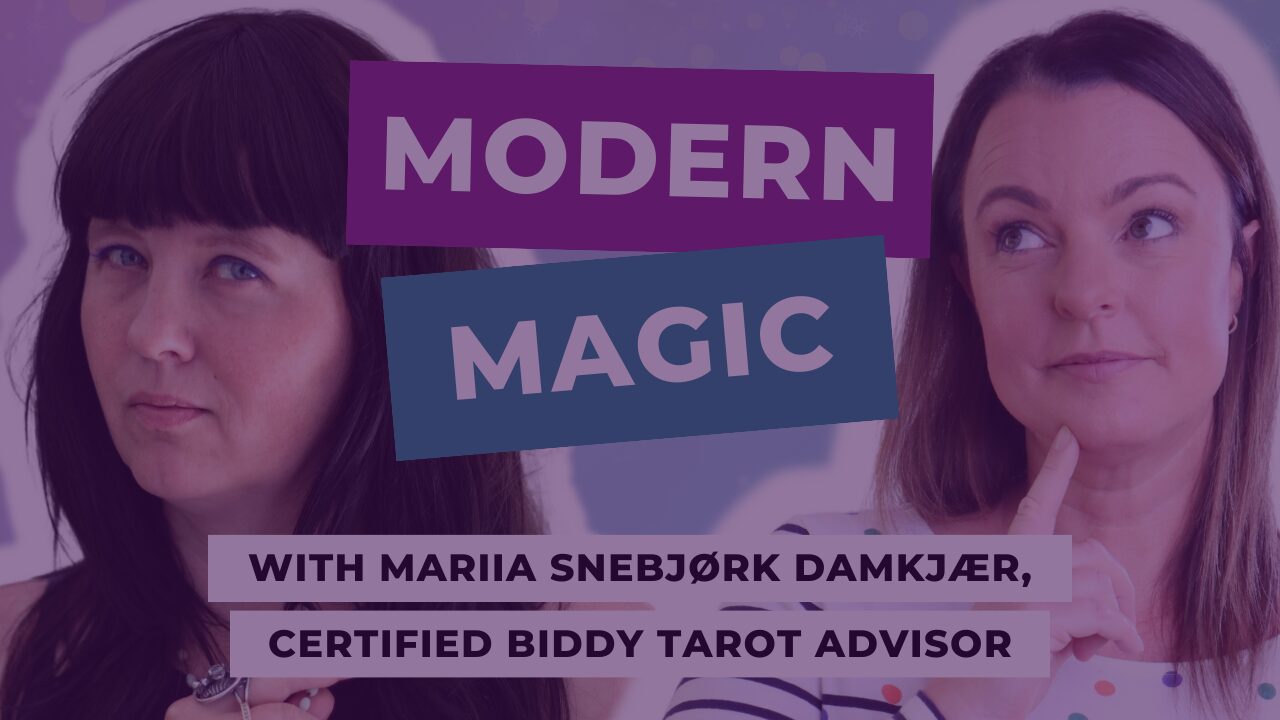
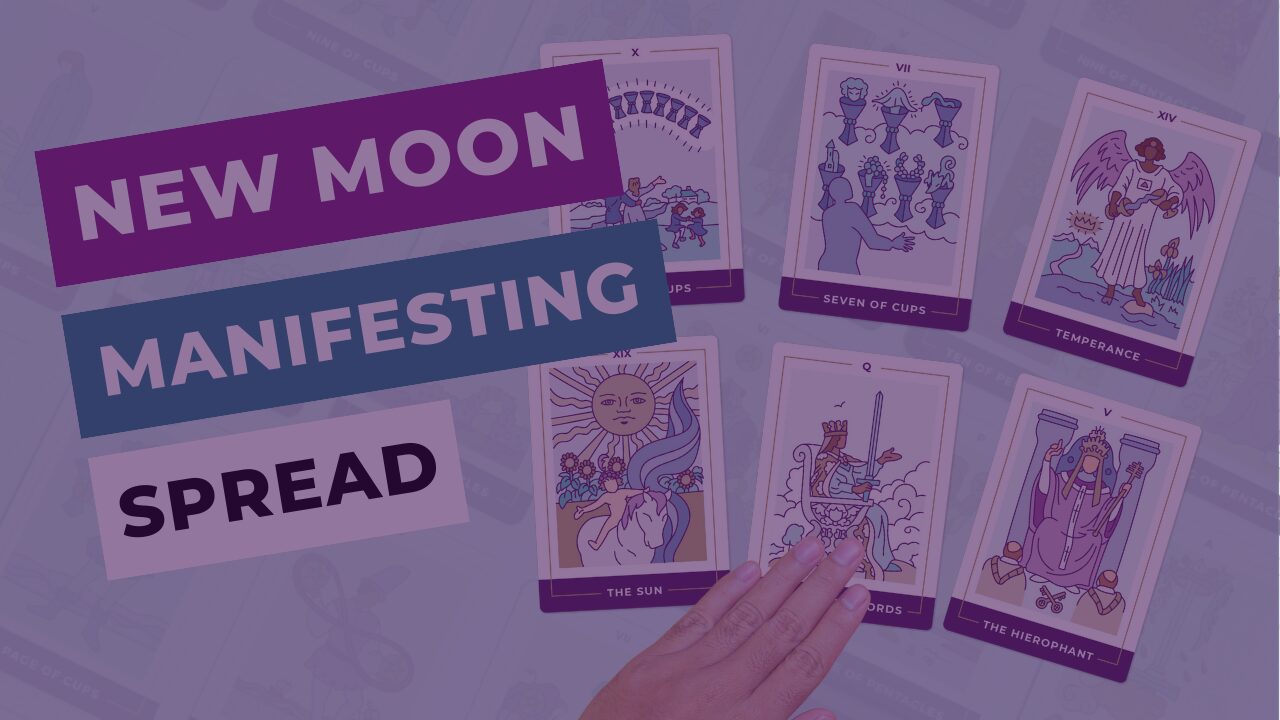

 Harness the wisdom of the Major Arcana with 22 guided meditations. Here’s what you’ll get:
Harness the wisdom of the Major Arcana with 22 guided meditations. Here’s what you’ll get: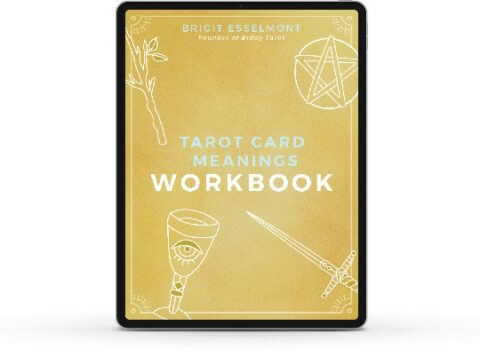 Create a deeply intuitive and personal connection to the Tarot cards with your very own Tarot Card Meanings Workbook. Here’s what you’ll find inside the workbook:
Create a deeply intuitive and personal connection to the Tarot cards with your very own Tarot Card Meanings Workbook. Here’s what you’ll find inside the workbook: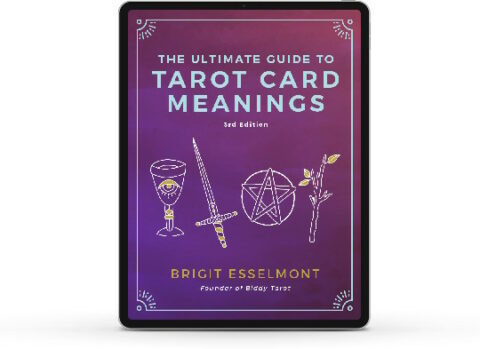 Here’s what you’ll find inside for every card in the deck:
Here’s what you’ll find inside for every card in the deck: Start doing deep, accurate readings TODAY with this step-by-step accelerated program for beginners.
Start doing deep, accurate readings TODAY with this step-by-step accelerated program for beginners.